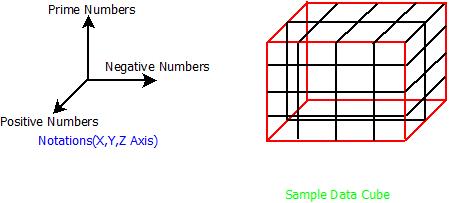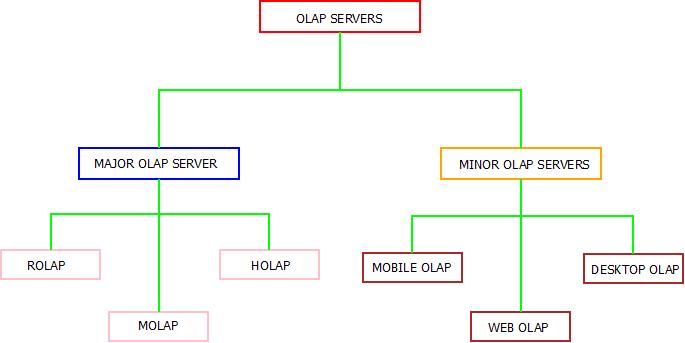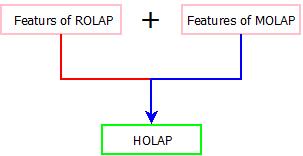Online Analytical Processing(OLAP) : Introduction
- Online Analytical Processing (OLAP) is a multidimensional data model that is used by professionals for analyzing multiple dimensions of data for knowledge discovery.
- This knowledge discovery will result in better decision making ability for those professional by using complex queries.
- OLAP is the first part among OLAP and OLTP, which when combined together forms a Data warehouse/Database. OLAP is responsible for dealing with historical data(i.e. past data) which is subject oriented in nature and this historical data helps in decision-making, analytics and report generation.
- One of the examples of multidimensional data model is Data cube. Each dimension of the data cube represents certain parameters, which can be used for knowledge discovery through data mining process.
- This sample data cube represents the category of numbers used. Each dimension represents one category of numbers i.e. Positive Number, Negative Numbers and Prime Numbers.

Data Cube : Online Analytical Processing
- Data cube concept is used because, analyst can turn around the data cube along its dimensions for all its possible combinations to determine and view each and every aspect of available data.
Online Analytical Processing(OLAP) : Servers
- OLAP servers represents the type of OLAP systems available that can be used according to the requirement. This requirement may include the use of relational data, Multidimensional data, web based data etc. Specific OLAP servers are used as per the data. These servers can be classified as either Major OLAP server or Minor OLAP server.

Online Analytical Processing Servers
Major Online Analytical Processing(OLAP) Servers
- Major OLAP servers includes three of them. These are ROLAP, HOLAP and MOLAP and are explained below.
1. ROLAP
- ROLAP stands for Relational Online Analytical Processing System. As the name suggests, ROLAP deals with the data present in any relational database. Relational database means, database whose data is represented or stored in the form of tables(Fields with rows and columns).
- For large scalable data, ROLAP servers can be used because of its high query processing ability which is capable of generating required/desired results. SQL is the most common query language that is used in ROLAP servers for result extraction.
- For example: Oracle OLAP, Microsoft Analysis Services are the most commonly used ROLAP Servers.
2. MOLAP
- MOLAP stands for Multidimensional Online Analytical Processing System. The major difference between ROLAP and MOLAP is, ROLAP is used when data is large whereas MOLAP is used when data scale is small.
- In MOLAP, data is stored in summarized manner in the form of data cube where every dimension of the data cube represents an attribute of data stored in it, as compared to the data stored in the form of tables in ROLAP.
- Multidimensional Online Analytical Processing System works on the concept of Data cube. As Data cube offer a number of views of data available in the data cube which can result in better decision making. Also, this can lead to data redundancy as every dimension might occur common in the different views.
- For example: Oracle Essbase and Micro strategy are the commonly used MOLAP Servers.
3. HOLAP
- HOLAP stands for Hybrid Online Analytical Processing System.

HOLAP : Online Analytical Processing
- HOLAP contains the best features of ROLAP and MOLAP all together making it the most efficient among all the available servers. HOLAP is capable of dealing with both relational databases as well as Data cube structured data sources(Multidimensional data sources). This results in flexibility and provide much larger data scalability than ROLAP and MOLAP.
- For example : Microsoft SQL Server is the most commonly used HOLAP Server.
Minor Online Analytical Processing Servers
- Minor OLAP servers also includes three of them. These are Mobile OLAP, Web OLAP and Desktop OLAP and are explained below.
1. Web OLAP
- Web OLAP(WOLAP) system enable users to use OLAP system directly, with combination of a web browser and an internet connection. It makes this system more user accessible because of its client-server architecture. Also, setting up Web OLAP is very easy as only a web browser and an internet connection are needed.
2. Mobile OLAP
- Mobile OLAP system enable users to use OLAP system directly through mobile. With the help of remote access feature, Mobile OLAP can be used as only a mobile device along with an internet connection are required.
3. Desktop OLAP
- Desktop OLAP(DOLAP) uses the concept of data fragmentation. It means, a part of data from Data sources(Such as Data bases/Data Warehouses) is extracted in the form of small fragments separately on the user’s desktop and knowledge discovery is done on that particular data fragment only. DOLAP setup requires an internet enabled Desktop/Laptop computer.
Advantages : OLAP Servers
- Decision Making.
- Knowledge Discovery.
- Data Mining.
- Large amount of data can be processed through a single query known as decision support query.
- OLAP servers provide consistent data outputs in the form of information, knowledge and calculations.
Disadvantages : OLAP Servers
- Complex structure of decision support queries.
- Performing operations on such large data sources can lead to system hanging or freezing.
- Prone to risk which might result into failures.
- Slow
- Depends totally on single field i.e. Information Technology.
Applications : OLAP Servers
- Report and Analytics Generation.
- Banking.
- Forecasting
- Finance Sector.
- Data Centres.